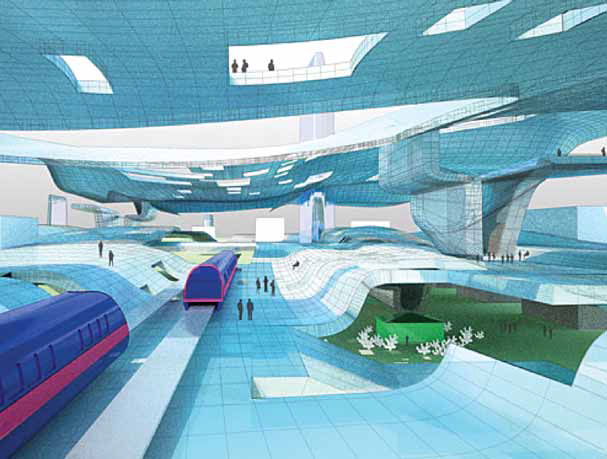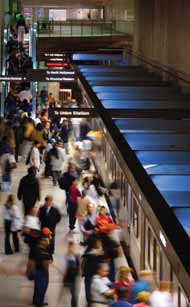
Architects must manage their work in increasingly complex professional and creative environments. This situation has been fueled by the economic downturn, certainly. Yet, while the practice of architecture has contracted in the traditional sense, the range of opportunities available to architects to build and shape the urban environment has expanded.
This distinction is critical in transportation. I have worked on both sides of the table in transportation—both as part of the design team working with various transit agencies, and more recently consulting to the Los Angeles Metropolitan Transportation Authority (Metro). Over the course of the last fifteen years, I’ve come to recognize that opportunities for this kind of expanded practice are particularly relevant and necessary.
Necessary, in the sense that transportation work is so complex, expensive, and resource intensive that it often takes the unique discipline architects possess to even approach the work strategically. For example, Measure R, recently passed in Los Angeles County, provides for nearly $40 billion for traffic relief and transit upgrades throughout the county over the next thirty years. Measure R will help fund dozens of countywide and local transit projects, create more than 210,000 new jobs and help jump-start the regional economy with additional tens of billions of dollars in economic activity. Additionally, local officials and Metro are promoting the 30/10 Initiative, a plan to accelerate financing for key projects and complete work that might otherwise take thirty years, in ten. Compounding the technical challenges that this kind of construction boom will create are the interface with existing financial, community development, and design initiatives: myriad local projects and programs, community advocacy groups, local, regional, and national political considerations, Federal and State oversight, Light Rail construction authorities, and other billion-dollar projects like the California High Speed Rail program and the American Recovery and Reinvestment Act, to name a few.
Architects’ distinctive training is relevant in this environment, because the need is great, the time in which to make difficult and important choices is relatively short, and the decisions many communities make now in relation to transportation will affect their sustainable growth for generations. This landscape would seem the natural domain of architects.

At Metro, architects already play key roles in the planning and execution of the agency’s work. Externally, a phalanx of planning and design consultants takes on studies, reports, urban design, and architectural work, most often as sub-consultants to larger engineering firms and design/build contractors, but also as prime contractors. Given the way many public procurements are structured, architects may also find sub-consultant positions under firms that might normally be subs to architects, such as environmental planners, facility planners, even graphic designers. A willingness to collaborate without controlling the whole process can be frustrating in some ways, but it can also be rewarding for an agile firm working in a promiscuous world of consulting and sub-consulting.
Architects are heavily represented in planning and engineering within Metro, but also lead in less traditional areas like environmental graphics and public art. There are key benefits to the agency in having many architects on both sides of the table. A shared professional culture allows architects to better understand each other as project issues are addressed. Strategic thinking allows for a more productive analysis of the issues at hand and the potential impact of other knock-on effects. Finally, a firm grounding in technical knowledge makes for more informed negotiation. Value engineering meetings are inevitably more grueling with so much information and with vocal advocates at hand, yet this common language is important when considering billion-dollar projects that have a 50- to 100-year operational life and will fundamentally affect the lives of millions.
While the potential impact of the work of architects in transportation may be profound, other aspects of professional practice are worth watching and can have an important influence on architects working within this typology. For example, in March of 2009, SCI-Arc and The Architect’s Newspaper jointly sponsored an ideas competition, “A New Infrastructure: Innovative Transit Solutions for LA/2009.” The images and ideas presented at a special roundtable at Metro had a palpable effect on the architects at the agency, if not directly, then in reinvigorating the dialogue and lending perspective to the countless ways in which transportation planning and design influence urban life.
Other proposals—some speculative, others through city or community initiatives—keep the ideas flowing, for the firms that propose them, for the advocates who lobby and agitate for them, and for those within transit agencies with the power to help make them a reality. Currently in Los Angeles are three or four serious proposals to deck over freeways with new city parks. Whether they all move forward or none do, these are excellent catalysts that invite architects to rethink the material place of transportation in the city, not just the logistical place of transit in an urban environment.
Proposals like these mesh well with current Metro initiatives to reconfigure traffic and transportation patterns in 21st century Los Angeles. Competitions reveal connections that may be explored further in professional settings. Resonances remain and may eventually become realities. Just as the Más Transit concept—the winning entry in “The New Infrastructure”—proposes overlaying a new high-speed rail infrastructure over the city of Los Angeles, so too are current planners wrestling with the challenges of overlaying a new high-speed rail station (the equivalent of a small airport) over the existing grid of Downtown L.A., to create a kind of super-inter-modal amalgam with historic Union Station. Like San Francisco’s planned Transbay Terminal, these are once-in-a-lifetime commissions, but they are also emblematic of transportation’s increasing influence on architecture and urbanism.

In a decade or so, Reyner Banham might no longer recognize the “4th ecology” of Los Angeles, the freeways; instead, he might find something equally artificial, but much more sustainable, more deliberate. As infrastructure is improved, new opportunities will present themselves for design, at local, regional, and even larger scales—hard-working, interconnected responses to design challenges of ever increasing nuance and complexity, tied to the framework of transportation.
Author Noam Maitless, AIA, LEED AP, is principal of Maitless+Associates, an architecture and planning studio in Los Angeles. He also writes about architecture and design for Esquire magazine.
Originally published 2nd quarter 2010 in arcCA 10.2, “The Future of CA.”






